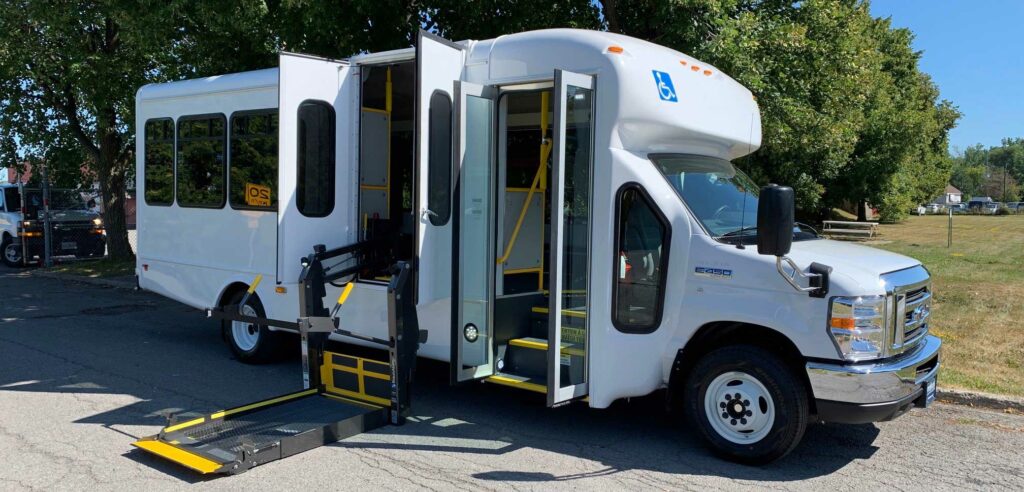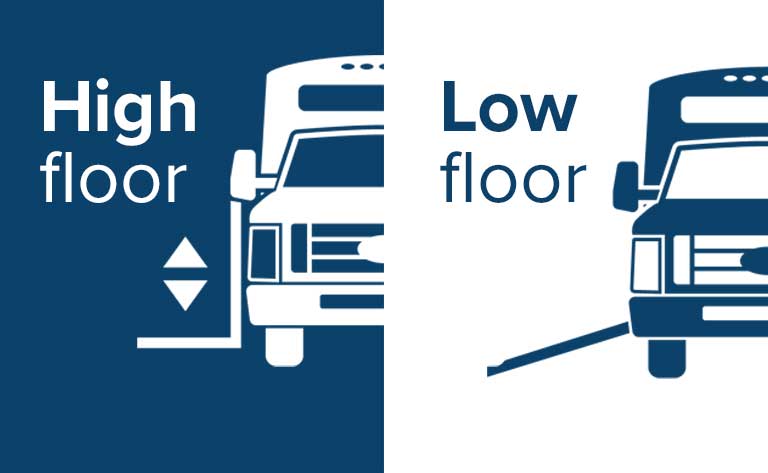In the early 90s, the low-floor bus appeared on Canadian roads, in Kitchener and Victoria. Since then, the Canadian market has been primarily focused on low-floor technology. Some provinces encouraged the transition to low-floor buses with policy directives and funding incentives to provide universal access to public transportation.
However, high-floor buses didn’t disappear from the map, especially in the commercial bus industry. Some of our customers still prefer high-floor buses, whether operating in the health care sector, in municipalities or offering shuttle services.
Our Crestline experts help you understand the difference between a high-floor and a low-floor bus by highlighting their specific advantages.
High-floor versus low-floor buses at a glance.
Advantages of the low-floor bus.

Easy accessibility.
Hassle-free mobility! With its lowered structure, the low-floor bus is a natural curb extension for anyone willing to take the bus (pedestrian or disabled). No steps, easy to go, it provides fast and secure entry and exit for all passengers. An unfolding ramp offers single access for everyone: children, adults with disabilities or not, seniors, parents with strollers, and people with packages. One way in!
Nice user experience.
Low-floor buses are known for their user-friendliness. The single entrance in the front offers easy access and a welcoming feeling from the driver. Studies show that low-floor bus drivers appreciate making eye contact with passengers from their seats. Also, low-floor buses feature higher ceilings, allowing manufacturers to offer more oversized windows, ultimately reducing the boxed-in sensation passenger can experience when the bus is crowded.
Better productivity.
Low-floor buses allow reduced stop dwell times. The ramp allows faster boardings and exits. Only one ramp cycle is required regardless of how many wheelchair passengers want to take the bus. On average, a ramp takes 10 seconds to unfold; this is three times faster than a lift cycle! And think further. We all know how fast an interior can get cold when a door is open during our winters. With a single entrance and a faster onboarding time, your passengers won’t freeze at each stop. Especially important when you transport seniors or fragile people; you don’t want them to get sick on your bus!
No lift maintenance costs.
Wheelchair lifts suffer from a mild reputation of being unreliable and very demanding maintenance. But, did you know that in the public transit industry, one reason why low-floor buses have become almost the universal bus of choice is the ramp? This accessibility feature has so many maintenance problems than the lifts on high-floor buses that it puts aside the conventional buses.
Today, wheelchair lifts technology has improved significantly, and they are much more robust than before. However, they still have many moving parts that may need to be replaced, which is why they need to be inspected regularly.
Government funding.
Public policies promote the low-floor adaption for passenger transportation. Some provinces or public institutions may have incentive programs. Talk to your local authorities to learn more about subsidies available for your low-floor bus purchase.
Advantages of a high-floor bus.

Better visibility.
Passengers sit higher above the roadway, enjoying a better view and comfort. Observations in public transit buses show that passengers tend to prefer seating in those higher sections, such as right behind the driver or on the wheel bumps— even if they prefer ramp accessibility. Take this into consideration if your bus is meant to go on highways or higher speed routes.
Higher seating capacity.
At equal size, high-floor buses can seat more passengers than low-floor buses because there is no floor space used by wheel wells.
Lower maintenance costs.
The chassis hasn’t been modified by the manufacturer, so parts are easily accessible based on the OEM structure. Replacement parts are cheaper, and their installation requires less technician time resulting in a more affordable repair bill. Also, the fact that the bus is higher reduces the chances of scraping the tires or getting wear on brake parts from curbs.
Better driveability in snow.
Even if low-floor buses can function in the snow, the simple fact of being higher on their wheels is an advantage for high-floor buses. It limits the loss of traction in deep snow and prevents from spinning and getting stranded in a snowbank. There is also less risk of damaging the lower body panels with ice and rocks.
Affordability.
Conventional buses have a lower acquisition cost than the low-floor models at a comparable level of features and quality.
Need more help to decide what kind of bus is better for your business? Let us help!
Our bus consultant can assess your situation and guide you to make the right decision for your transportation needs.




